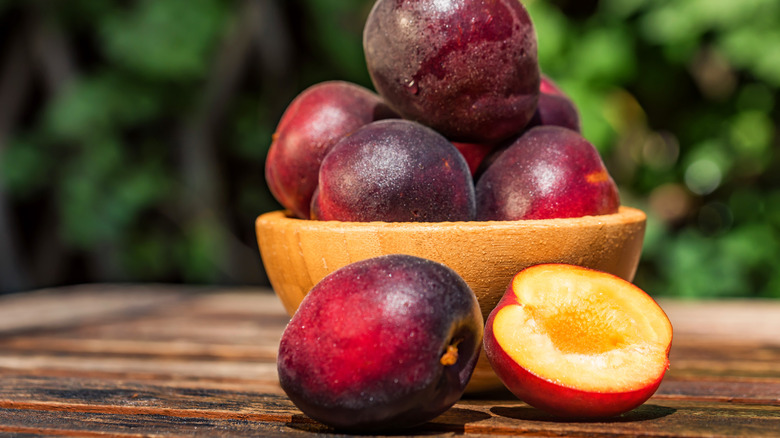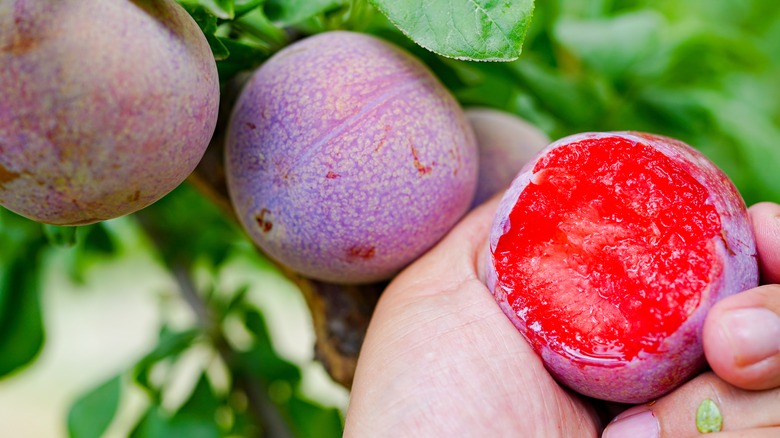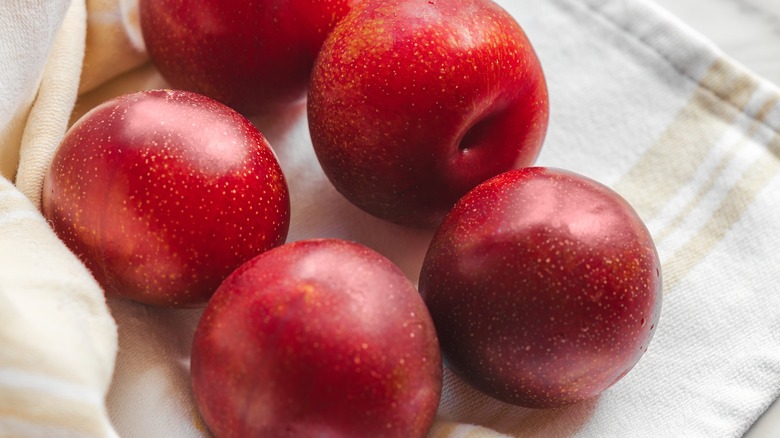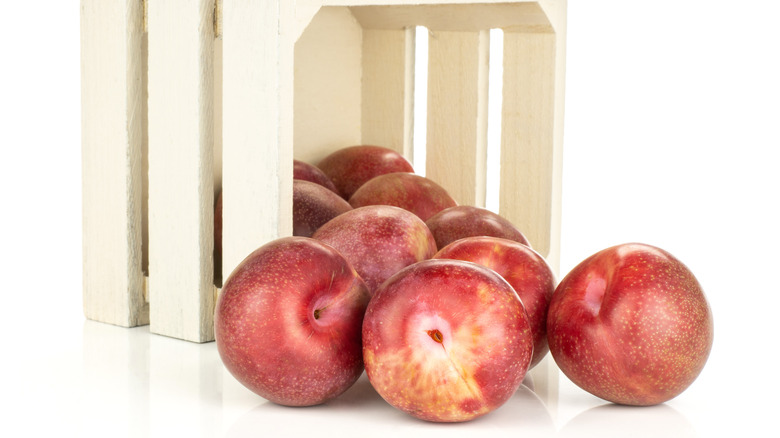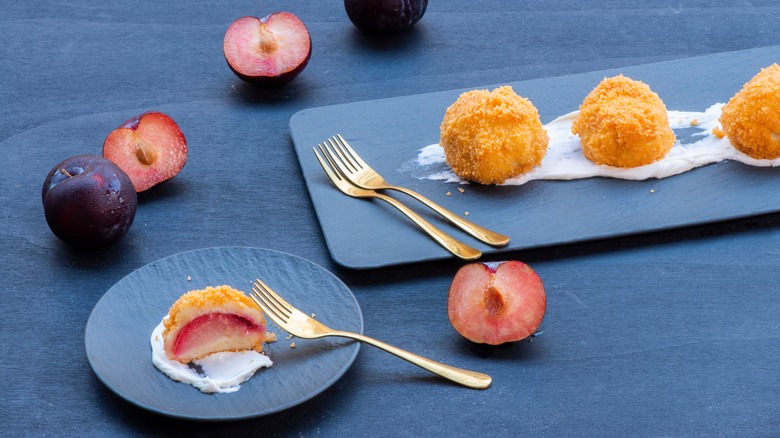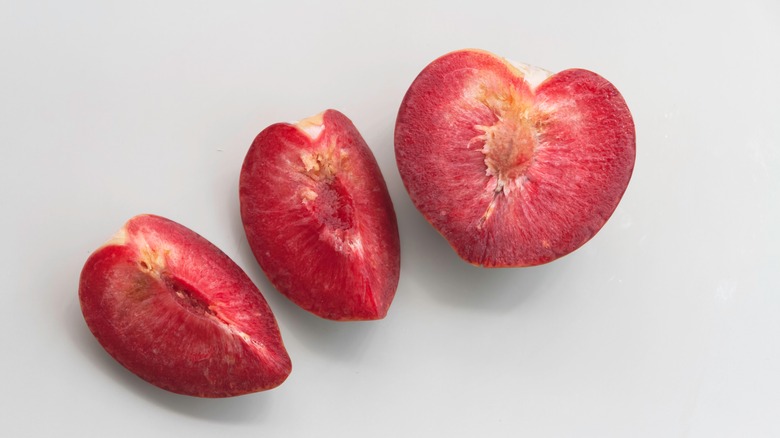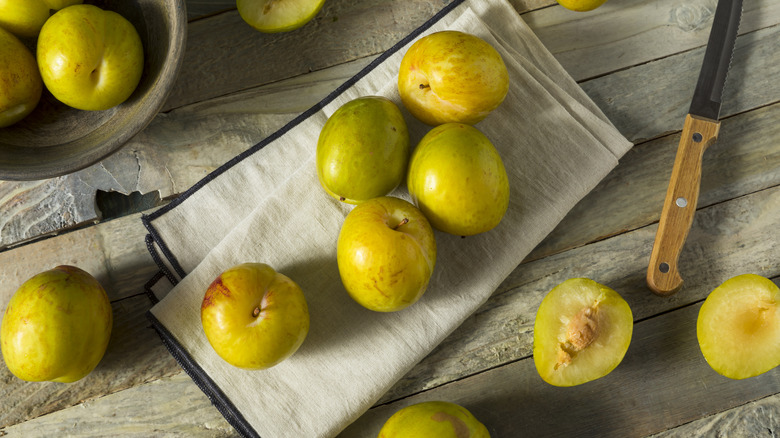Pluots: The Hybrid Fruit Plum Fans Will Adore
There's nothing better than biting into a sweet, juicy fruit on a warm day. And while we love peaches, blackberries, and mangos, some of the less talked about spring and summer fruits can be some of the most delicious. May to July is apricot season, the perfect time for eating these little orange stone fruits fresh or making them into a cobbler or jam.
And plums take over in July, becoming ripe for the picking until October. These succulent purple fruits are perfect for making into a plum upside-down cake, or even drying and eating as prunes.
But what if you want the best of both worlds? Enter the pluot, a man-made hybrid fruit that captures the flavors of both apricots and plums, and whose season overlaps both of its parents. Pluots fall under the prunus genus, making them close relatives of peaches, cherries, and almonds.
While you could make the same old cobbler every year, try whipping up a summer dish with pluots instead, and you'll be left wondering why you ever ate plums and apricots separately. Let's find out what these sweet hybrids taste like, and who came up with the idea to marry these two fruits.
What are pluots?
A pluot is exactly what it sounds like — a cross between a plum and an apricot. But the split isn't 50/50, as pluots are three-quarters plum and one-quarter apricot. In this way, they differ from other plum-apricot mashups like apriums, in which apricots' qualities take the center stage, and plumcots, which are half plum and half apricot.
Since the majority of a pluot's qualities come from a plum, it's unsurprising that it mostly resembles its purple parent fruit. Pluots typically have thin, smooth skin, and are small to medium in size. While you'll most likely see them appear reddish or purple, pluots can also be gold, green, or nearly black.
While pluots may be one of the more popular crossbred fruits today, you couldn't find them before the 1980s. They were first bred by farmer-geneticist Floyd Zaiger in the late 1980s in California. These fruits weren't Zaiger's only masterpiece, however, as he is also credited with creating apriums and has been dubbed "the most prolific stone fruit breeder in the modern era," per Veritable Vegetable.
The fruits weren't originally called pluots, either — the first-ever pluot was inspired by the plumcot, and was called the Plum Parfait and Flavorella. Only in the 1990s was the plum content increased and the fruit was given the pluot name.
Pluots vs. plumcots
Since pluot creator Floyd Zaigar drew inspiration from plumcots when creating this new hybrid, the two are pretty similar. They're both California natives, although plumcots were bred by Luther Burbank in the early 1900s, and today the fruits are mostly cultivated in California's San Joaquin Valley. Pluots and plumcots can both show up in a variety of colors, but a pluot's skin is usually smooth, while a plumcot's can be either smooth or a little fuzzy.
As you would expect from a 50/50 plum-apricot hybrid, plumcots have more of an apricot taste than pluots do. Both lean more heavily on their plum flavors, but pluots tend to be sweeter, while plumcots are tangier and have floral notes from their apricot parent. However, they are both high in sugar, which makes them a delicious ingredient in the same dishes: pies, galettes, crumbles, cobblers, and more.
And while both pluots and plumcots thrive in the warmer months, plumcots have a much shorter season than pluots. While pluots are usually available from spring to fall, you'll typically only see plumcots from May to early July – so make sure to nab these sweet little fruits up while you can.
What do pluots taste like?
Pluots are sweeter than plums, and their sugary flavor almost overpowers any lingering tartness. When biting into a plum, you may taste some acidity from the skin, which is usually fairly bitter. However, a pluot's skin draws its taste from apricots, making for sweet bites from start to finish. This intense sugariness makes pluots prime candidates for fruit-based desserts and smoothies.
Compared to plums, pluots are crisper in texture. Their flesh is a bit more like an apricot than a plum – it tends to be firmer to the touch and isn't overflowing with juice. This texture change was created intentionally and may have even been the reason pluots were created in the first place. Pluot creator Floyd Zaiger set out to make a fruit that had the flavor of a plum but the firmness of an apricot — and judging by today's pluots, it's safe to say he succeeded.
How to cook with pluots
Pluots are intensely sweet, so it only makes sense to include them in dessert recipes. And luckily, there are a ton of ways to use these unique stone fruits. Since pluots are in season from spring to fall, the obvious ways to use them are in summer desserts — think cobblers, pies, crumbles, and galettes.
They're so sweet, in fact, that you may not even need to add any extra sugar to the filling. However, you can also slice up and add pluots to fresh recipes like salads, yogurt bowls, or salsa to serve over chicken or fish.
But the options don't end there — because pluots are so similar in flavor to plums, you can usually substitute them for plums in a variety of recipes, sweet or savory. For example, try making pluot jam, chutney, or barbecue sauce, or wrap slices with prosciutto and pair them with cheese for a sweet and salty appetizer. If you're making a cheese board, try pairing pluots along with creamy cheeses like goat cheese or mozzarella.
One of the easier ways to eat pluots is by throwing them in a smoothie — they'll work well as a replacement for plums or apricots in any smoothie recipe. Or, dig into a fresh, juicy pluot by itself for a candy-like snack.
Where to buy pluots
Although pluots are gaining more traction worldwide, they are still the easiest to find in their home state of California. In the Golden State, they can be found in grocery stores, health food stores, and farmers markets when they're in season, from late spring to fall.
You may even have luck at big chains like Whole Foods and Vons – and if you're trying to find the original plum-apricot hybrid, plumcots, you may be able to nab those at Trader Joe's. Or, you can try going straight to the source and visit orchards that grow these stone fruits.
If you're not in California, it gets a little tricker to find pluots, although not impossible. The fruits are also grown in Washington and are distributed to grocery stores all over the country, although you may have to do a little digging to locate them beyond the West Coast.
Once you do track down pluots, you'll want to make sure they're free from bruises before purchasing, although they should give a little when touched, and exude a sweet aroma. If you can only find hard ones, though, that shouldn't deter you from buying pluots — just like avocados, you can keep them on the counter until they're ripe.
Nutritional information about pluots
As you may expect from an intensely sweet fruit, pluots do have a good amount of sugar — about 15 grams for a serving of two pluots, to be exact. However, don't let that deter you from trying these delicious stone fruits. Pluots have a low glycemic index and a good amount of fiber, meaning that you shouldn't experience the same sugar highs and crashes that you would from eating foods with table sugar, according to Verywellfit. In this way, pluots may be a beneficial food for those with diabetes.
And if you are reaching for something sweet, a pluot is one of the more nutritious options you could go for. They're high in vitamin A, which can help maintain healthy organs, vitamin C, which may benefit the immune system, and potassium. Pluots are also a low-calorie food, as one pluot only contains about 35 calories on average. They also contain trace amounts of iron, calcium, and protein.
These vitamins and minerals mean that pluots may help your digestive system, hair and skin, blood pressure, and heart health – all while satisfying your sweet tooth, per DoveMed.
Other varieties of pluots
With pluots being such a unique fruit hybrid, it's easy to assume there's only one type, but there are in fact many varieties of pluots — and they all have fun names to match. For example, you may stumble across Dinosaur Egg, Red Ray, and Flavor Penguin pluots, or Dapple Dandies and Flavor Queens. In fact, there are more than 80 varieties of pluots in the U.S., although California cultivates most of them.
The different types of pluots come in a rainbow of colors with slightly varying flavors. Black Kats are aptly named for their black skin, while Dinosaur Eggs get their name from their green and red spotted skin. And Flavor Grenades barely resemble plums at all – the fruits are green and yellow, turning slightly red when ripe, and have flavor notes of pineapple and grape.
So how can such a specific hybrid generate so many different varieties? The pluot name is actually trademarked, so farmers can't use the name to label their fruits. The trademark has sparked nurseries like Dave Wilson's Nursery to instead sell their fruit under names like Candy Stripe, which quickly sweetens as it ripens, and Emerald Drop, which looks like a green gem as it hangs on trees. So the next time you're at the grocery store, don't just seek out pluots specifically, as these sweet fruits may be sold under their stage names instead.
